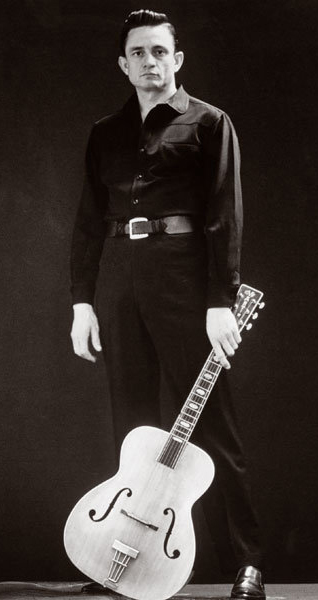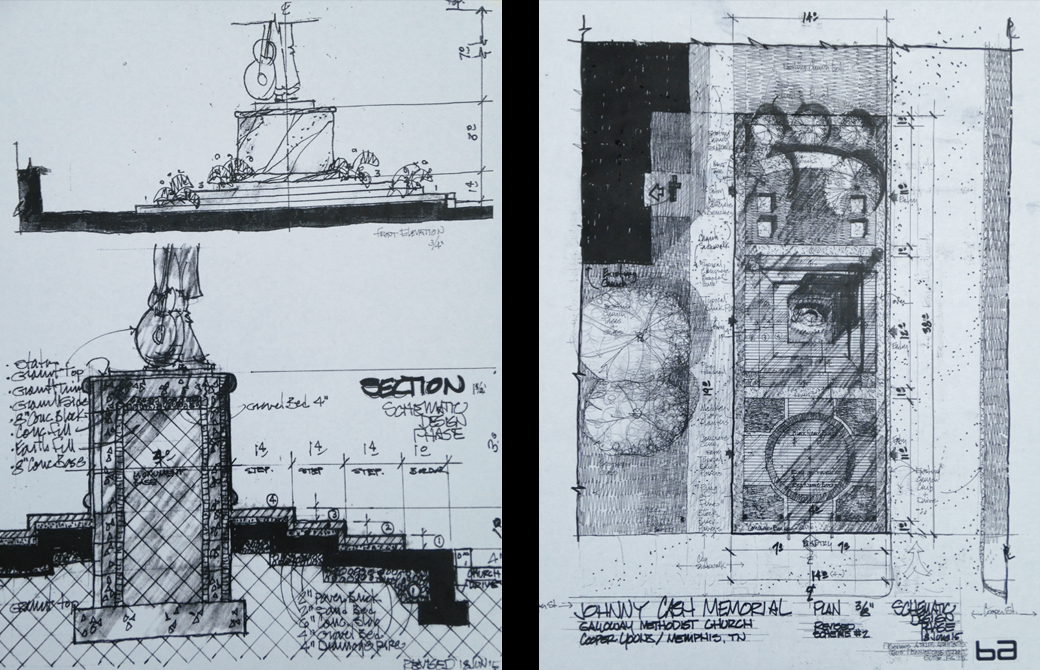
“Hello, I’m Johnny Cash.”
In 2009 I interviewed Marshall Grant who played bass with Johnny Cash in the “Tennessee Two”. This interview was recorded in the basement of the Galloway Church (now called Cooper-Walker Place) in a space called ‘The Abbey’, which still functions today as a venue for local musicians. Grant confirmed that, indeed, in that room, the very first Johnny Cash performance happened. The event was a church bake sale in December, 1954. Grant even revealed that he, Cash and guitar player Luther Perkins had never stood on the well-worn stage, but in the opposite corner of the room.
Based on my interest in preserving Memphis’ musical past (which includes working for Sun Studio for 4 years, saving WHBQ at the Hotel Chisca, and continuing my work as a local tour guide), it occurred to me that my Cooper-Young neighborhood (in which I have lived for 17 years) could do something to commemorate the event of Johnny Cash’s first show. I began to imagine what a Johnny Cash statue might look like, placed in front of the former Galloway Church.
In 2011, I took the ‘music statue concept’ to Tupelo, Mississippi where I pitched the Convention and Visitors Bureau on a bronze statue to commemorate the upcoming 35th anniversary of Elvis Presley’s passing. The statue was to be placed near the site on the former fairgrounds where Elvis had performed his homecoming show in September 1956. The statue was to be based on the famous photograph by Roger Marshutz, showing Elvis’s right arm outstretched, not just to the girls in the front row, but to the very middle class itself, a sign of hope, a symbol for the American dream.
The Tupelo Convention and Visitors Bureau committed $50K to the project. The Tupelo Elvis Fan Club raised the remaining 25K and the statue was unveiled an astonishing eleven months later, mounted into place on the morning of the event by sculptor Bill Beckwith. The Elvis Statue has now become, in every way, a part of the fabric of Tupelo.

Committee Member Chip Armstrong holds concept art by Mike McCarthy

Photo by Leigh Wiener
CURRENT STATUS
The first Legacy Memphis project is the Johnny Cash statue and historic marker in the Cooper-Young neighborhood. Cooper Walker Place, which now operates in the old Galloway Methodist Church, has agreed to let the northeast corner become the statue’s permanent home. Co-Owners Sam Garrett and Ken Steorts are granting an easement to the Cooper-Young Community Association of the 14 feet x 38 rectangle area for the next 99 years. Architect Bemis Atkins has prepared the schematics and design work, and the property was flagged for a general contractors estimate on Friday, June 18, 2015.

VISION
Legacy Memphis proposes to establish a series of statues throughout the city of Memphis honoring our musical and artistic legacy. These statues will invite visitors into historic neighborhoods and park vicinities near historic recording studios such as Sun, Stax, Ardent, or Royal. The Project would utilize planning and design that would show city pride, gain national attention, seize economic opportunities, and present more reasons for people to visit Memphis. People will want to live in a city that honors it’s own rich musical and artistic legacy.
Let’s put a seven foot tall bronze Otis Redding statue in Soulsville. Let’s put Alex Chilton in Overton Square. Let’s put a Willie Mitchell statue in Orange Mound. Let’s make a Sam Phillips statue park in Health Sciences Park one block over from Sun Studio, and create an inviting landscape for the medical students and tourists to visit Howlin’ Wolf, Rufus Thomas, Carl Perkins, (among others) who recorded one block away.
Other examples could mean The Beatles, Isaac Hayes, Larry Finch, or Sputnik Monroe at a repurposed Mid-South Coliseum, the Million Dollar Quartet at Health Sciences Park, or David Bowie at the Memphis College of Art.
TALENT AND BUDGET
Sculptor Bill Beckwith has agreed to sculpt, cast and mount the finished 7 foot tall bronze upon payment of 75K. Mississippian Beckwith, who has established himself as the go-to artist for Memphis and Mississippi legends. He’s created busts and statues of Elvis Presley for Tupelo’s Fairpark District, B.B. King for his hometown of Indianola, William Faulkner at Oxford’s city hall, and Jim Henson and Kermit the Frog for the Greenville, Mississippi, library.
Jimmy Ogle, who heads up the Shelby County Historical Commission is heading the committee to create and install the Historic Marker which will inform the reader about Johnny Cash’s first performance at the Galloway Methodist Church as well as Cooper-Walker Place’s new musical direction. The complete cost of the marker is $2,500.
Project Lead Mike McCarthy will coordinate with all committees and fundraising efforts for the proposed 2016 unveiling of statue and marker. The General Contractor will create the plaza area containing brick, foundation, and grass for the amount of $2,500.
The grand total for the statue, marker, and plaza are $110,335. We have already raised $10,335.
Please go to our IOBY link and give toward the Johnny Cash Statue and Historic Marker.
Schematics by Bemis Atkins

Shelby County Historical Commission
Marker Letter by President Jimmy Ogle
Johnny Cash Historical Marker
Legacy Memphis and the Shelby County Historical Commission are proud to announce the dedication of an historical marker for Johnny Cash on May 1, 2016 in the Cooper-Young District at 1015 Cooper-Walker Place (formerly the Galloway Methodist Church), where Johnny Cash made his first public appearance in Memphis, Tennessee. May 1, 2016 is the release date of his most popular Sun record "I Walk The Line".
Over the past few years, the Shelby County Historical Commission has dedicated markers in recognition of some the amazing achievements in Memphis Music History, such as:
- Elvis Presley And Sun Records, 706 Union Avenue
- Lansky Brothers – Clothier To The King, 126 Beale Street
- Plastic Products Record Plant – Hub Of Rock ‘n’ Roll, 1746 Chelsea Avenue
- American Studios – 831 Thomas Street
Recently the SCHC has coordinated ceremonies for music-oriented markers of the Tennessee Historical Commission for Saturday Night Jamboree (165 Madison Avenue) and Humes High School (659 North Manassas Street). These dedication ceremonies, such as the American Studios dedication last year with Chips Moman and the Memphis Boys, often bring together in a homecoming spirit, the greats that actually made that history for us all!
More than two hundred historical markers dot the Memphis and Shelby County landscape, recognizing the significant achievements of many Memphians in all walks of life. The markers program is very popular with locals and tourists alike. In August, 2015, markers will be dedicated at Poplar Tunes (308 Poplar Avenue) and Lauderdale Courts (282 North Third Street), and then a marker at WHBQ at Hotel Chisca in 2016.
These beautiful cast aluminum markers are 33” X 43” in size and contain almost 1,600 spaces for text denoting the significance of the person, place or event. Sewah Studios in Marietta, Ohio is the fabricator, and the cost of such a marker is approximately $2,500.00, which includes the marker panel, 7’ pole, shipping and installation (by SCHC). Sponsors of each markers bear the cost, as the Shelby County Historical Commission receives no funds from Shelby County government for its oversight of Shelby County history by resolution of the Shelby County Board of Commissioners.
Legacy Memphis and the SCHC Markers Committee will write the text with full documentation in committee, and then present a final text for approval to the full Shelby County Historical Commission. The entire process takes about three months to complete.
Heritage Tourism is alive and well in Memphis, Tennessee and the historical marker program is a very important piece of the preservation, education and enjoyment for all generations.
Commercial Appeal, ‘Memphis Music Beat’,
May 6, 2015 - by Bob Mehr
If things go according to plan, next spring Memphis will see “The Man in Black” officially become “The Man in Bronze.” A coalition of music enthusiasts, historians, and community organizers have launched an effort to place a statue of American music icon Johnny Cash at the intersection of Cooper and Walker streets. The location, site of the former Galloway United Methodist Church, is where Cash and his band the Tennessee Two played their first show in late 1954.
The $75,000 project will be created by noted sculptor Bill Beckwith and is set to be unveiled in May 2016, marking the 60th anniversary of the release of Cash’s first Sun Records single, “I Walk the Line.” A multiphase fundraising campaign has been launched at crowd-resourcing platform ioby. Organizers are hoping to generate just over $10,000 in the next week from the public as they set about tapping bigger private donors.
“This is the grassroots phase, an opportunity for the Memphis community to get this project off the ground,” says John Bass, program manager of Rhodes College’s Mike Curb Institute for Music. Rhodes and the Curb Institute are part of a coalition — which also includes Cooper Walker Place, the Visible Music College, the Cooper Young Community Association, and filmmaker/preservationist Mike McCarthy — hoping to create a meaningful marker for Cash, who launched his career in the Bluff City.
“We’re trying to recognize Cash and what he meant to Memphis,” says Bass. “This timing of this initial funding push is to really get the process going to get the sculpture completed in time to be ready for the ‘I Walk the Line’ anniversary next year.”
The sculpture — which will be 7 feet tall with a 4-foot base, and modeled on photo of Cash from his late- ’50s heyday — will be done by Mississippian Beckwith, who has established himself as the go-to artist for Memphis and Mississippi legends. He’s created busts and statues of Elvis Presley for Tupelo’s Fairpark District, B.B. King for his hometown of Indianola, William Faulkner at Oxford’s city hall, and Jim Henson and Kermit the Frog for the Greenville, Mississippi, library.
McCarthy, who also helped spearhead the Presley statue effort in Tupelo, has worked closely with Beckwith. “Bill is someone I know and personally trust with this. He’s worked with many public institutions, under demanding deadlines and always performed with this great touch,” says McCarthy. “Also Bill played in garage bands back in the ’60s; he has a rock and roll aesthetic to his sculpture and has been involved with several music-oriented projects, so he’s really the perfect person.”
Cooper Walker Place, which now operates in the old Galloway Church, has agreed to let the corner outside the building become the statue’s permanent home, adding a point of historical significance to its placement. It was there, during December 1954, that Cash, guitarist Luther Perkins and bassist Marshall Grant made their live debut.
Bob Mehr, Commercial Appeal, ‘Memphis Music Beat’, May 6, 2015
copyright 2015 by Mike McCarthy